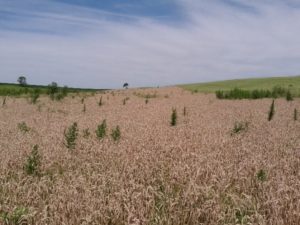Tips for Saving Money With Weed Control in Small Grains
Small grains can benefit a farm’s rotation by breaking pest, disease and weed cycles and improving soil health.
 “Growing small grains allows me to put in a super diverse cover crop mix immediately following my small grain harvests so that we can really boost the productivity of the soil long term,” says Wade Dooley, who started growing small grains in 2014. However, if not managed properly and grown in the optimal order, weeds, pests and diseases can quickly become issues.
“Growing small grains allows me to put in a super diverse cover crop mix immediately following my small grain harvests so that we can really boost the productivity of the soil long term,” says Wade Dooley, who started growing small grains in 2014. However, if not managed properly and grown in the optimal order, weeds, pests and diseases can quickly become issues.
Wade shared his insights on weed control for small grains in an April 2024 shared learning call, focusing on tips for reducing unnecessary costs.
Rotations
The lowest cost option for managing weeds is cultural. To break weed cycles, avoid planting small grains following other small grains. They will share similar life cycles, allowing the same types of weeds to dominate.
Wade cautions, “If you end up with a bunch of weeds that happen to match up life cycles with your small grains – for example, pennycress, marestail, white cockle, or any of the winter annuals – they can really cause problems at the wrong time.”
He also advises farmers to pay attention to each field, noting what weeds are prevalent there, and choose small grains that will not have to compete with those specific weeds.
Most importantly, Wade wants farmers to keep in mind, “You don’t fix a field of weeds with one season of small grains. If you try to do that, you’ll have a lot of weeds in your small grain and then you have to fix that problem too.” Weeds must be managed across all seasons to be effectively mitigated.

A cover crop on Wade’s farm helps to separate small grains in rotation and mitigate risk of disease.
Tools
Varying levels of soil disturbance have been used for millennia to manage weeds in fields, and can do so effectively, but not without costly tradeoffs. Organic producers use tillage and mechanical weed control as they do not have the option of spraying herbicides. No-till farmers like Wade, however, avoid this option due to the risk of increasing soil erosion and diminishing soil health.
Wade acknowledges that tillage can be very helpful in controlling weeds, but advises, “It’s also very good for planting weeds, so you have to make sure to time it well.” Farmers should ensure that mechanically controlled weeds are not tilled under the soil right when they are going to seed.
Herbicides
Herbicide is the highest cost option for weed control in small grains, but it also has the potential to be the most efficient. If a farmer chooses to use herbicide, it should be sprayed before a small grain has reached the jointing stage, when the growing point emerges above the surface of the soil.
In spring 2024, Wade confirmed with his chemical dealer that herbicide application would cost $30/acre. He chose not to spray because the timing wasn’t right and would risk damaging the grain he planned to harvest. In that situation, the herbicide cost was not worth the marginal benefit. “I don’t want to damage a crop by using a chemical at the wrong growth stage, so learning how to stage a small grain is really important.”
Staging is the practice of observing the phases of development for a small grain crop and making management decisions based on the benefits or costs to the crop at any given growth stage.
Wade asserts that spraying herbicide on a small grain when it is nearly ready to harvest causes far more harm than good, including to human and animal health. “There are processors that will refuse grain that has had glyphosate applied to it. You have to be aware of that before you pull the trigger on that product.”
Creative alternatives
In some cases, weeds still become prevalent in a field despite efforts to eradicate or control them. Yet, this isn’t always cause for despair. Wade has been able to put small amounts of weeds through the combine when green and they were not thick enough to cause issues in the equipment.

Wade determined that the weed pressure in this wheat field was not enough to cause issue, so he just ran them all through the combine with the wheat.
In one specific situation, he had a lot of foxtail growing up under his wheat crop, but rather than try to control those weeds, he found another option.
“I bolted my grain head rigid, picked it up high, took just the heads of the rye and left all the foxtail that was nice and green. When we got done combining, I came back in with the hay mower, made straw and killed the weeds.”
With this creative solution, Wade spent no money on herbicides, but still successfully controlled the weeds, harvested a crop and made straw.
Additional Resources
- PFI video: Crop Rotation for Weed Suppression – Organic Weed Control
- From Michigan State University Extension: Weed Control in Small Grains
- From Penn State Extension: Herbicide Recommendations for Winter Small Grains
Sign up for PFI’s monthly Small Grains News email newsletter to receive program updates, small grains resources and information on upcoming events.
Register for our upcoming small grains shared learning calls via Zoom.
Learn about and apply for our small grains cost-share program.
